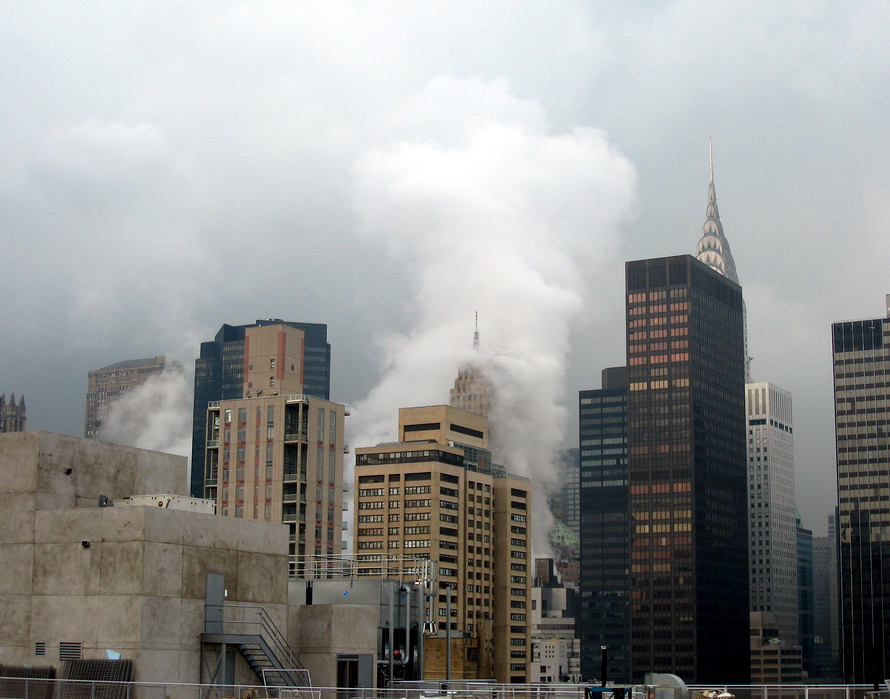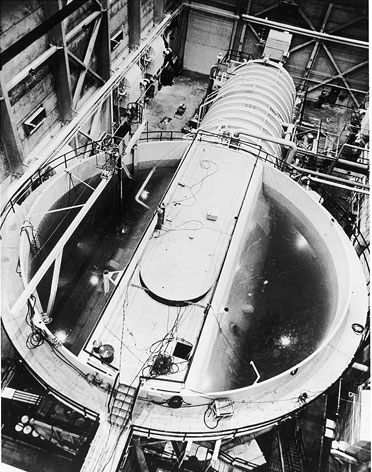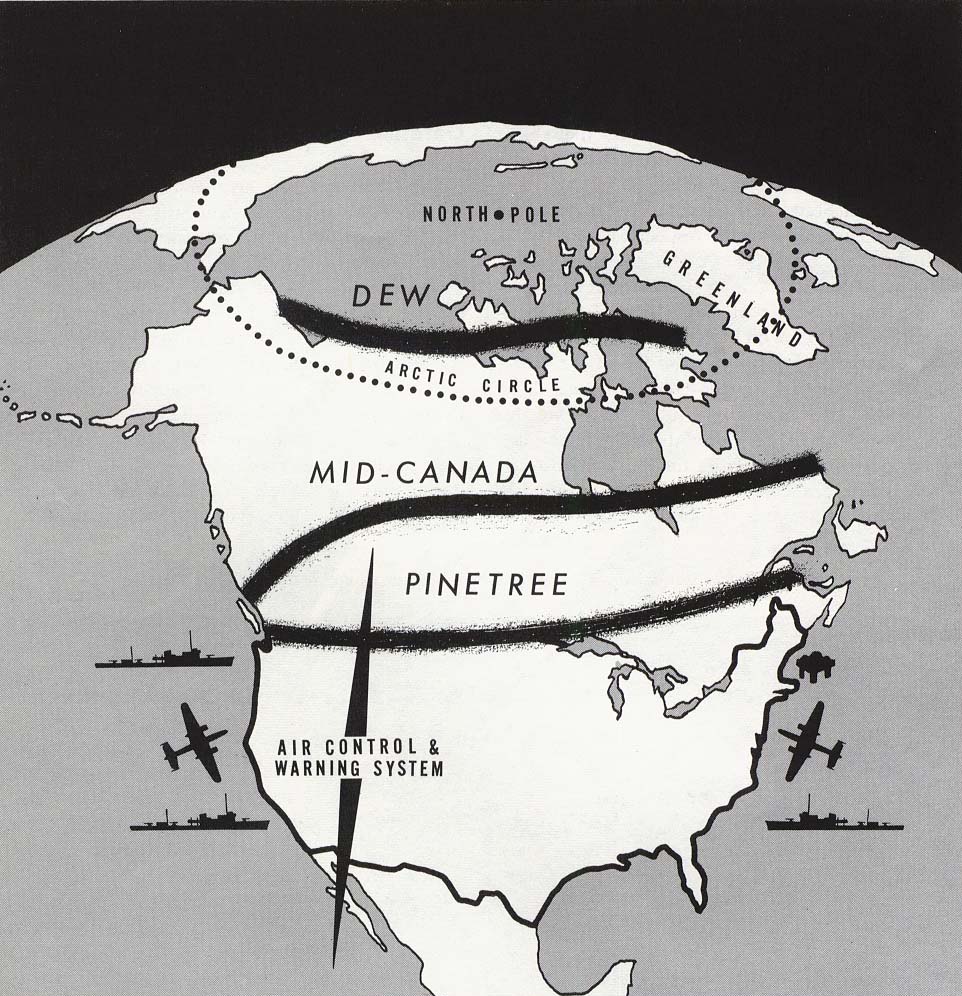|
SL-1
Stationary Low-Power Reactor Number One, also known as SL-1 or the Argonne Low Power Reactor (ALPR), was a United States Army experimental nuclear reactor in the western United States at the National Reactor Testing Station (NRTS), later the Idaho National Laboratory, west of Idaho Falls, Idaho. It experienced a steam explosion on the night of January 3, 1961, killing all three of its young military operators, and pinning one of them to the ceiling of the facility with a reactor vessel plug. The event is the only reactor accident in U.S. history that resulted in immediate fatalities. The direct cause was the over-withdrawal of the central control rod, responsible for absorbing neutrons in the reactor's core. The accident released about of iodine-131, which was not considered significant due to its location in the remote high desert of eastern Idaho. About of fission products were released into the atmosphere. The facility housing SL-1, located approximately west of Idah ... [...More Info...] [...Related Items...] OR: [Wikipedia] [Google] [Baidu] |
Army Nuclear Power Program
The Army Nuclear Power Program (ANPP) was a program of the United States Army to develop small pressurized water and boiling water nuclear power reactors to generate electrical and space-heating energy primarily at remote, relatively inaccessible sites. The ANPP had several accomplishments, but ultimately it was considered to be "a solution in search of a problem." The U.S. Army Engineer Reactors Group managed this program and it was headquartered at Fort Belvoir, Virginia. The program began in 1954 and had effectively terminated by about 1977, with the last class of NPP operators graduating in 1977. Work continued for some time thereafter either for decommissioning of the plants or placing them into SAFSTOR (long term storage and monitoring before decommissioning). The current development of small modular reactors has led to a renewed interest in military applications. Background There was interest in the possible application of nuclear power to land-based military needs as ea ... [...More Info...] [...Related Items...] OR: [Wikipedia] [Google] [Baidu] |
Steam Explosion
A steam explosion is an explosion caused by violent boiling or flashing of water or ice into steam, occurring when water or ice is either superheated, rapidly heated by fine hot debris produced within it, or heated by the interaction of molten metals (as in a fuel–coolant interaction, or FCI, of molten nuclear-reactor fuel rods with water in a nuclear reactor core following a core-meltdown). Pressure vessels, such as pressurized water (nuclear) reactors, that operate above atmospheric pressure can also provide the conditions for a steam explosion. The water changes from a solid or liquid to a gas with extreme speed, increasing dramatically in volume. A steam explosion sprays steam and boiling-hot water and the hot medium that heated it in all directions (if not otherwise confined, e.g. by the walls of a container), creating a danger of scalding and burning. Steam explosions are not normally chemical explosions, although a number of substances react chemically with steam (for ... [...More Info...] [...Related Items...] OR: [Wikipedia] [Google] [Baidu] |
Idaho National Laboratory
Idaho National Laboratory (INL) is one of the national laboratories of the United States Department of Energy and is managed by the Battelle Energy Alliance. While the laboratory does other research, historically it has been involved with nuclear research. Much of current knowledge about how nuclear reactors behave and misbehave was discovered at what is now Idaho National Laboratory. John Grossenbacher, former INL director, said, "The history of nuclear energy for peaceful application has principally been written in Idaho". Various organizations have built more than 50 reactors at what is commonly called "the Site", including the ones that gave the world its first usable amount of electricity from nuclear power and the power plant for the world's first nuclear submarine. Although many are now decommissioned, these facilities are the largest concentration of reactors in the world. It is on a complex in the high desert of eastern Idaho, between Arco to the west and Idaho Fal ... [...More Info...] [...Related Items...] OR: [Wikipedia] [Google] [Baidu] |
Idaho Falls, Idaho
Idaho Falls (Shoshoni language, Shoshoni: Dembimbosaage) is a city in and the county seat of Bonneville County, Idaho, Bonneville County, Idaho, United States. It is the state's largest city outside the Boise metropolitan area. As of the 2020 United States Census, 2020 census, the population of Idaho Falls was 64,818.2020 Census, US Census Bureau, Idaho Falls, Idaho Profile In the 2010 United States Census, 2010 census, the population of Idaho Falls was 56,813 (2019 estimate: 62,888), with a metro population of 133,265. Idaho Falls serves as the commercial, cultural, and healthcare hub for Eastern Idaho, as well as parts of western Wyoming and southern Montana. It is served by the Idaho Falls Regional Airport and is home to the College of Eastern Idaho, Museum of Idaho, and the Idaho Falls Chukars minor league baseball team. It is the principal city of the Idaho Falls Idaho Falls metropolitan area, Metropolitan Statistical Area and the Idaho Falls–Blackfoot-Rexburg, Idaho Co ... [...More Info...] [...Related Items...] OR: [Wikipedia] [Google] [Baidu] |
International Nuclear Event Scale
The International Nuclear and Radiological Event Scale (INES) was introduced in 1990 by the International Atomic Energy Agency (IAEA) in order to enable prompt communication of safety significant information in case of nuclear accidents. The scale is intended to be logarithmic, similar to the moment magnitude scale that is used to describe the comparative magnitude of earthquakes. Each increasing level represents an accident approximately ten times as severe as the previous level. Compared to earthquakes, where the event intensity can be quantitatively evaluated, the level of severity of a man-made disaster, such as a nuclear accident, is more subject to interpretation. Because of this subjectivity the INES level of an incident is assigned well after the fact. The scale is therefore intended to assist in disaster-aid deployment. Details A number of criteria and indicators are defined to assure coherent reporting of nuclear events by different official authorities. There ar ... [...More Info...] [...Related Items...] OR: [Wikipedia] [Google] [Baidu] |
Control Rod
Control rods are used in nuclear reactors to control the rate of fission of the nuclear fuel – uranium or plutonium. Their compositions include chemical elements such as boron, cadmium, silver, hafnium, or indium, that are capable of absorbing many neutrons without themselves decaying. These elements have different neutron capture cross sections for neutrons of various energies. Boiling water reactors (BWR), pressurized water reactors (PWR), and heavy-water reactors (HWR) operate with thermal neutrons, while breeder reactors operate with fast neutrons. Each reactor design can use different control rod materials based on the energy spectrum of its neutrons. Control rods have been used in nuclear aircraft engines like Project Pluto as a method of control. Operating principle Control rods are inserted into the core of a nuclear reactor and adjusted in order to control the rate of the nuclear chain reaction and, thereby, the thermal power output of the reactor, the rate of stea ... [...More Info...] [...Related Items...] OR: [Wikipedia] [Google] [Baidu] |
Nuclear Reactor
A nuclear reactor is a device used to initiate and control a fission nuclear chain reaction or nuclear fusion reactions. Nuclear reactors are used at nuclear power plants for electricity generation and in nuclear marine propulsion. Heat from nuclear fission is passed to a working fluid (water or gas), which in turn runs through steam turbines. These either drive a ship's propellers or turn electrical generators' shafts. Nuclear generated steam in principle can be used for industrial process heat or for district heating. Some reactors are used to produce isotopes for medical and industrial use, or for production of weapons-grade plutonium. , the International Atomic Energy Agency reports there are 422 nuclear power reactors and 223 nuclear research reactors in operation around the world. In the early era of nuclear reactors (1940s), a reactor was known as a nuclear pile or atomic pile (so-called because the graphite moderator blocks of the first reactor were placed into a tall pi ... [...More Info...] [...Related Items...] OR: [Wikipedia] [Google] [Baidu] |
Los Alamos National Laboratory
Los Alamos National Laboratory (often shortened as Los Alamos and LANL) is one of the sixteen research and development laboratories of the United States Department of Energy (DOE), located a short distance northwest of Santa Fe, New Mexico, in the American southwest. Best known for its central role in helping develop the first atomic bomb, LANL is one of the world's largest and most advanced scientific institutions. Los Alamos was established in 1943 as Project Y, a top-secret site for designing nuclear weapons under the Manhattan Project during World War II.The site was variously called Los Alamos Laboratory and Los Alamos Scientific Laboratory. Chosen for its remote yet relatively accessible location, it served as the main hub for conducting and coordinating nuclear research, bringing together some of the world's most famous scientists, among them numerous Nobel Prize winners. The town of Los Alamos, directly north of the lab, grew extensively through this period. After ... [...More Info...] [...Related Items...] OR: [Wikipedia] [Google] [Baidu] |
Los Alamos Scientific Laboratory
Los Alamos National Laboratory (often shortened as Los Alamos and LANL) is one of the sixteen research and development laboratories of the United States Department of Energy (DOE), located a short distance northwest of Santa Fe, New Mexico, in the American southwest. Best known for its central role in helping develop the first atomic bomb, LANL is one of the world's largest and most advanced scientific institutions. Los Alamos was established in 1943 as Project Y, a top-secret site for designing nuclear weapons under the Manhattan Project during World War II.The site was variously called Los Alamos Laboratory and Los Alamos Scientific Laboratory. Chosen for its remote yet relatively accessible location, it served as the main hub for conducting and coordinating nuclear research, bringing together some of the world's most famous scientists, among them numerous Nobel Prize winners. The town of Los Alamos, directly north of the lab, grew extensively through this period. After t ... [...More Info...] [...Related Items...] OR: [Wikipedia] [Google] [Baidu] |
Distant Early Warning Line
The Distant Early Warning Line, also known as the DEW Line or Early Warning Line, was a system of radar stations in the northern Arctic region of Canada, with additional stations along the north coast and Aleutian Islands of Alaska (see Project Stretchout and Project Bluegrass), in addition to the Faroe Islands, Greenland, and Iceland. It was set up to detect incoming bombers of the Soviet Union during the Cold War, and provide early warning of any sea-and-land invasion. The DEW Line was the northernmost and most capable of three radar lines in Canada and Alaska. The first of these was the joint Canadian-United States Pinetree Line, which ran from Newfoundland to Vancouver Island just north of the Canada–United States border, but even while it was being built there were concerns that it would not provide enough warning time to launch an effective counterattack. The Mid-Canada Line (MCL) was proposed as an inexpensive solution using bistatic radar. This provided a "trip w ... [...More Info...] [...Related Items...] OR: [Wikipedia] [Google] [Baidu] |
Gigawatt
The watt (symbol: W) is the unit of power or radiant flux in the International System of Units (SI), equal to 1 joule per second or 1 kg⋅m2⋅s−3. It is used to quantify the rate of energy transfer. The watt is named after James Watt (1736–1819), an 18th-century Scottish inventor, mechanical engineer, and chemist who improved the Newcomen engine with his own steam engine in 1776. Watt's invention was fundamental for the Industrial Revolution. Overview When an object's velocity is held constant at one metre per second against a constant opposing force of one newton, the rate at which work is done is one watt. : \mathrm In terms of electromagnetism, one watt is the rate at which electrical work is performed when a current of one ampere (A) flows across an electrical potential difference of one volt (V), meaning the watt is equivalent to the volt-ampere (the latter unit, however, is used for a different quantity from the real power of an electrical circuit). : \m ... [...More Info...] [...Related Items...] OR: [Wikipedia] [Google] [Baidu] |
Arctic
The Arctic ( or ) is a polar regions of Earth, polar region located at the northernmost part of Earth. The Arctic consists of the Arctic Ocean, adjacent seas, and parts of Canada (Yukon, Northwest Territories, Nunavut), Danish Realm (Greenland), Finland, Iceland, Norway, Russia (Murmansk Oblast, Murmansk, Siberia, Nenets Autonomous Okrug, Nenets Okrug, Novaya Zemlya), Sweden and the United States (Alaska). Land within the Arctic region has seasonally varying snow and sea ice, ice cover, with predominantly treeless permafrost (permanently frozen underground ice) containing tundra. Arctic seas contain seasonal sea ice in many places. The Arctic region is a unique area among Earth's ecosystems. The cultures in the region and the Arctic indigenous peoples have adapted to its cold and extreme conditions. Life in the Arctic includes zooplankton and phytoplankton, fish and marine mammals, birds, land animals, plants and human societies. Arctic land is bordered by the subarctic. De ... [...More Info...] [...Related Items...] OR: [Wikipedia] [Google] [Baidu] |






